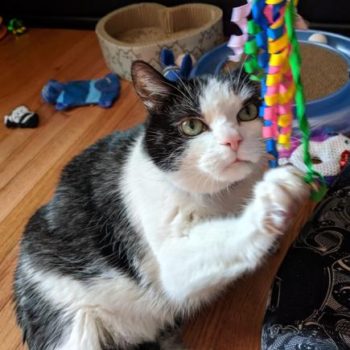This guest post is written by Stefanie Sacripante, Director of NoVa Cats Advocacy, Inc. Sacripante has been using social media to give voice to overlooked adult cats in shelters, rescues, and foster homes in the Northern Virginia region since 2014.
When cats urinate in places other than the litterbox and once medical issues are ruled out, thinking creatively is vital. The following are examples that may seem complex at first glance, but were resolved by looking at the entire context of the cat’s situation.
So adoptable, if he only used the box!
Lovable chubster Max was a consistent litter box user before his urinary tract infection. Physically recovered, he still preferred the same floor spots to relieve himself and was returned. Perhaps the soiled areas still had the lingering odor that tempted him? While in a new foster home, he continued to urinate inappropriately even though his foster mom offered up an uncovered box, and varying types and depths of unscented litter. It was discovered that Max’s UTI had dragged on for months. During that period, every trip to the box was a reminder of the pain, so he needed to be coaxed past that mental hump. With a cat attractant sprinkled onto his litter, Max was immediately lured back to the box. The negative association was broken and he found a family almost immediately.
Pretty kitty twice adopted, twice returned
Young tortie Missy was a nervous girl, who consistently used her litter box at the shelter, but was returned twice because she hadn’t once used the box in either home. Both adopters had the prescribed quiet homes, so what happened? If health is not a factor, the clue here is her shyness. Both homes had multiple floors so how was she introduced into each one? Even if Missy was initially confined to a small room until she acclimated, a home with two or three floors can still be overwhelming for a timid cat. A woman with a modest apartment became smitten with Missy, but was reluctant given her history. To ease the potential adopter’s mind and to be absolutely sure the cat was poised for litter box victory this time, I offered to settle Missy in her new home. Deal sealed, Missy’s new mom was counseled to keep her confined to the bathroom until the box was used for both #1 and #2. Five years later, Missy has never done her business anywhere but where she is supposed to.
A Serial Pee-er May Need a Combination of Remedies.
Oreo, an easy going love-nugget, bounced around various homes for two years. Oreo’s past scared off prospective families since he was a sporadic but indiscriminate serial pee-er. Whether the homes had children or not, cats or not, stuff on the floor or not, Oreo would urinate in various places, in addition to the litter box. I decided to foster Oreo and combed through the long paper trail from previous adopters, fosters, vets and a behaviorist. Plug-in pheromone diffusers and anxiety meds had been tried, without success. To ease Oreo into yet another transition, I put a pheromone collar on him the second he arrived. Since my foster room also happens to be a teenager’s messy bedroom, I was quite surprised that there were no incidents. Soon after, the resident cats would occasionally wait outside the door, more curious about the additional food source than they were the fresh foster. Instead of hissing at the sniffing noses under the door, Oreo reacted with piqued curiosity. After a few days (against our usual foster protocol), I let the most non-reactive resident cat in the room for a short visit and Oreo immediately perked up. This discovery was surely a variable to his future litter box success, as a more confident cat pal could reduce whatever occasional anxiety he felt. For Oreo to put his best paw forward though, the usual common stressors would need to be reduced – a smaller home with someone around frequently. Oreo’s happy ending turned out to be in an apartment with a semi-retired gentleman, whose cat also needed a friend. Oreo was seen off to his forever home with a three-month supply of pheromone collars and has had no further incidents.
Resolving a cat’s out-of-box experiences can be challenging, but a little out-of-box thinking can shed light on what is causing this frustrating behavior.
Do you have questions for Stefanie, or want to continue the conversation? We’ve started a thread on this blog in Maddie’s Pet Forum, where you can engage with her and continue the conversation!

